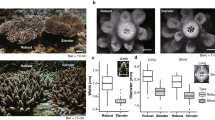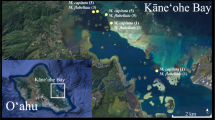Abstract
In Okinawa, Japan, we found several species of the coral genus Acropora that spawn 1.5–3 h earlier than other mass-spawning acroporids. In six early-spawning species, gamete bundles appear on the surface of the colony ("setting") about 1 h before sunset, whereas setting occurs about 1 h after sunset in the more common late mass spawners. These early spawners are divided further into two sub-groups: three species that release their gametes within 1 h after setting and three that release their gametes 1.5–2 h after setting. DNA phylogenetic analyses show that each of these groups forms an independent genetic clade. These genetic relationships suggest that different spawning times form the basis of reproductive isolation among these broadcast-spawning corals. Late spawning appears to be the ancestral state, and the shift of spawning to earlier times may have played a role in the speciation process in these sympatric species.


Similar content being viewed by others
References
Babcock RC, Bull GD, Harrison PL, Heywaed AL, Oliver JK, Wallace CC, Willis BL (1986) Synchronous spawning of 105 scleractinian coral species on the Great Barrier Reef. Mar Biol 90:379–394
Fadlallah YH (1996) Synchronous spawning of Acropora clathrata coral colonies from the western Arabian Gulf (Saudi Arabia). Bull Mar Sci 59:209–216
Fukami H, Omori M, Hatta M (2000) Phylogenetic relationships in the coral family Acroporidae, reassessed by inference from mitochondrial genes. Zool Sci (Tokyo) 17:689–696
Harrison PL, Babcock RC, Bull GD, Oliver JK, Wallace CC, Willis BL (1984) Mass spawning in tropical reef corals. Science 223:1186–1189
Hatta M, Fukami H, Wang W, Omori M, Shimoike K, Hayashibara T, Ina Y, Sugiyama T (1999) Reproductive and genetic evidence for a reticulate evolutionary history of mass spawning corals. Mol Biol Evol 16:1607–1613
Hayashibara T, Shimoike K, Kimura T, Hosaka S, Heyward AJ, Harrison PL, Kudo K, Omori M (1993) Patterns of coral spawning at Akajima Island, Okinawa, Japan. Mar Ecol Prog Ser 101:253–262
Knowlton N (1993) Sibling species in the sea. Annu Rev Ecol Syst 24:189–216
Knowlton N, Mate JL, Guzman HM, Rowan R, Jara J (1997) Direct evidence for reproductive isolation among the three species of the Montastraea annularis complex in Central America (Panama and Honduras). Mar Biol 127:705–711
Odorico D, Miller DJ (1997) Variation in the ribosomal internal transcribed spacers and 5.8S rDNA among five species of Acropora (Cnidaria; Scleractinia): patterns of variation consistent with reticulate evolution. Mol Biol Evol 14:465–473
Omori M, Fukami H, Kobinata K, Hatta M (2001) Significant drop of fertilization of Acropora corals in 1999: an after-effect of heavy coral bleaching? Limnol Oceanogr 46:704–706
Palumbi SR (1994) Genetic divergence, reproductive isolation, and marine speciation. Annu Rev Ecol Syst 25:547–572
Pratchett MS, Gust N, Goby G, Klanten SO (2001) Consumption of coral propagules represents a significant trophic link between corals and reef fish. Coral Reefs 20:13–17
Szmant AM, Weil E, Miller M, Colon DE (1997) Hybridization within the species complex of the scleractinian coral Montastraea annularis. Mar Biol 129:561–572
van Oppen MJH, McDonald BJ, Willis B, Miller DJ (2001) The evolutionary history of the coral genus Acropora (Scleractinia, Cnidaria) based on a mitochondrial and a nuclear marker: reticulation, incomplete lineage sorting, or morphological convergence? Mol Biol Evol 18:1315–1329
Van Veghel MLJ (1994) Reproductive characteristics of the polymorphic Caribbean reef building coral Montastrea annularis. Mar Ecol Prog Ser 109:201–219
Veron JEN (1986) Corals of Australia and Indo-Pacific. Angus and Robertson, Sydney, Australia
Veron JEN, Wallace CC (1984) Scleractinia of East Australia, part V. Aust Inst Mar Sci Monogr Ser 6:1–485
Wallace CC (1999) Staghorn corals of the world: a revision of the genus Acropora. CSIRO, Collingwood, Victoria, Australia
Wallace CC, Willis BL (1994) Systematics of the coral genus Acropora: implication of new biological findings for species concepts. Annu Rev Ecol Syst 25:237–262
Wang W, Omori M, Hayashibara T, Shimoike K, Hatta M, Sugiyama T, Fujisawa T (1995) Isolation and characterization of a mini-collagen gene encoding a nematocyst capsule protein from a reef-building coral, Acropora donei. Gene 152:195–200
Willis BL, Babcock RC, Harrison PL, Wallace CC (1997) Experimental hybridization and breeding incompatibilities within the mating systems of mass spawning corals. Coral Reefs 16[Suppl]:53–65
Acknowledgements
We thank Mr. S. Hosaka, the chairman of the Establishment of Tropical Marine Ecological Research, for encouragement of the study, Mr. K. Iwao for technical assistance and Dr. N. Knowlton for critical reading of the manuscript and valuable suggestions. This work was supported by grants from The Japan Science Association and the Nippon Foundation to H.F. and M.O., Sumitomo Foundation, Yamada Science Foundation and Grants-in-Aid for Scientific Research by the MEXT, Japan, to M.H.
Author information
Authors and Affiliations
Corresponding author
Additional information
Communicated by T. Ikeda, Hakodate
Rights and permissions
About this article
Cite this article
Fukami, H., Omori, M., Shimoike, K. et al. Ecological and genetic aspects of reproductive isolation by different spawning times in Acropora corals. Marine Biology 142, 679–684 (2003). https://doi.org/10.1007/s00227-002-1001-8
Received:
Accepted:
Published:
Issue Date:
DOI: https://doi.org/10.1007/s00227-002-1001-8




